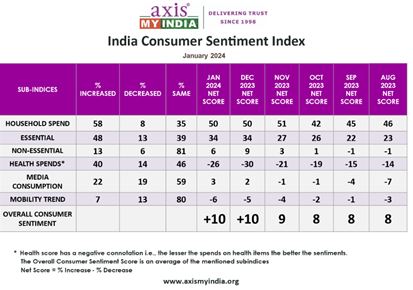5, Jan 2024
Luxury Spending During New Year Shopping – Axis My India January 2024 CSI Survey
Bangalore, 5th January 2024: Axis My India’s latest insights from the India Consumer Sentiment Index (CSI) paint an optimistic picture of evolving consumer behaviours and spending trends as we step into a new year. The report highlights a steady increase in household spending among 58% of families, complemented by a significant rise in essential spending, reflecting a conscious prioritisation of daily necessities. Amidst the festive sparkle, a discernible 18% of consumers are embracing the joy of luxury, while a robust 79% display a preference for economical choices, showcasing a healthy balance in financial strategies. As the New Year dawns, it is encouraging to see a focused 14% of the populace engaging in proactive financial planning, indicative of a growing financial awareness and foresight. These insights, mirroring a dynamic economic landscape, signal not just an adaptation to current circumstances but also a forward-looking approach in consumer spending, suggesting a year of promising opportunities and mindful financial choices ahead.
The December net CSI score, calculated by percentage increase minus percentage decrease in sentiment, is at +10.3, which is an increase of +0.3 from the last month.
The sentiment analysis delves into five relevant sub-indices – Overall household spending, spending on essential and non-essential items, spending on healthcare, media consumption habits, entertainment & tourism trends.
The survey used Computer-Aided Telephonic Interviews and included 4603 participants from 35 states and UTs. Among them, 70% were from rural areas and 30% from urban areas. In terms of regions, 25% were from the North, 27% from the East, 31% from the West, and 17% from the South of India. Among the participants, 59% were male and 41% were female. Looking at the largest groups, 28% were aged between 36 and 50 years old, while 27% were aged between 26 and 35 years old
Commenting on the CSI report, Pradeep Gupta, Chairman & MD, Axis My India, said, “As we start the New Year, our findings offer a lens into the dynamic interplay of consumer choices and financial strategies. The festive period, with its unique blend of luxury spending and economical choices, reflects a complex yet telling narrative about our society’s financial adaptability and prudence. This nuanced approach to consumption and fiscal planning indicates a deepening awareness among individuals and families of the need to balance present enjoyment with future security. Looking ahead, these trends suggest a positive trajectory for the coming year – one where mindful spending, strategic financial resolutions, and an embrace of both traditional and digital realms signify a society that is not only adapting to changing economic landscapes but also shaping them. As we step into the New Year, we see a horizon where financial decisions are increasingly informed by a blend of immediate needs and long-term aspirations, heralding a future rich with informed choices and sustainable growth.”
Key findings
· Overall household spending has increased for 58% of the families. Consumption remains the same for 35% of families. The net score is +50 which is the same as last month.
· Spends on essentials like personal care & household items have increased for 48% of families. Consumption remains the same for 39% of families. The net score is at +34 this month.
· Spends on non-essential & discretionary products like AC, Car, and Refrigerators have increased for 13% of families. Consumption remains the same for 81% of families. The net score, which was +9 last month, is at +6 this month.
· Expenses towards health-related items such as vitamins, tests, and healthy food have surged for 40% of the families. Consumption remains the same for 46% of families. The health score which has a negative connotation i.e., the lesser the spends on health items the better the sentiments, has a net score value of -26 this month.
· Consumption of media (TV, Internet, Radio, etc.) has increased for 22% of families which is an decrease by 1% from last month. The net score, which was +2 last month, is at +3 this month.
· Mobility has increased for 7% of the families. The net score, which was -5 last month, is at -6 this month. Mobility remains the same for 80% of the families.
On topics of current national interest
· As the festive lights of Christmas and New Year’s Eve illuminate the consumer landscape, a notable trend emerges from the background of retail. Amidst the season’s sparkle and temptation for lavish goods, 18% of the respondents plan to splurge on luxury items such as high-end electronics and fashion. 79% of the respondents intend to observe the festivities more economically, opting for budget-friendly choices as the year concludes. This contrast in spending habits offers a glimpse into the diverse financial strategies of households, navigating between festive indulgence and financial prudence.
· The advent of the New Year traditionally inspires a flurry of resolutions, with financial goals often topping the list for many. The latest survey data presents an intriguing narrative with 14% of respondents set to ring in the New Year with financial resolutions, pointing to a select group focused on reshaping their fiscal habits. 83% of the respondents will step into the New Year without financial resolutions, suggesting a satisfaction with their existing financial strategies. This divergence in financial forward-planning underscores the varied approaches to personal finance as a new calendar year unfolds.
· The New Year often serves as a catalyst for financial introspection, a time when many choose to focus on tax planning and investment reviews. In the spirit of fresh starts, a dedicated 14% of the respondents are proactive in their approach and engage in specific financial planning activities such as tax planning and investment reviews. 84% of the respondents do not indulge to participate in these financial planning activities implying a confidence in their ongoing financial strategies or a preference for a less seasonal approach to financial management. This landscape of financial activity highlights a population that values both planned financial recalibration and steadfast financial continuity.
· The landscape of media consumption has significantly shifted in the wake of widespread smartphone use and affordable internet access. As streaming platforms gain momentum, fuelled by the digital revolution, 25% of respondents have pivoted away from traditional cable or satellite subscriptions, opting instead for the on-demand convenience of digital streaming services. Despite this trend, a notable 40% of the respondents continue to engage with media through the conventional route of cable subscriptions. This persistence of traditional media consumption alongside the rise of streaming highlights the coexistence of old and new media paradigms, reflecting a diverse consumer base with varied preferences and habits in the digital age.
· The survey explored the intricate landscape of content consumption across TV and Video Streaming Platforms/OTT, revealing diverse viewer preferences:
o Serials on TV are favoured by 19% of the respondents
o Movies are watched on TV by 20% of respondents, with another 20% of the respondents enjoying them on both TV and video streaming platforms/OTT
o Sports content is equally popular on both mediums, with 22% of respondents tuning into both TV and video streaming platforms/OTT
o Long-form videos or content on video streaming platforms are the choice for 16% of respondents.
o Short-form videos or content on video streaming platforms attract 22% of respondents.
This diverse breakdown underscores a significant shift in media consumption habits, with digital platforms gaining prominence.
· In examining TV viewership data, distinct patterns in content consumption become evident across various age groups:
o For TV serials, 19% of respondents aged 36-50, and 51-60 engage in watching, while a slightly higher 21% of the respondents of those above 60 years tune into these shows
o When it comes to watching movies on TV, 21% of the respondents of 18-25 age group are viewers, closely followed by 20% in both the 26-35 and 36-50 age brackets. The 51-60 age group is not far behind, with 19% indulging in movies on TV.
o As for sports viewing on TV, 18% of the respondents of 18-25 age group are keen watchers, while the interest slightly increases to 19% among the 26-35 age group, and notably, 21% of respondents above 60 years also actively tune in to watch sports
· The findings of Video Streaming Platform/OTT viewership data reveals varied content preferences across different age groups:
o In the comedy genre, 16% of respondents aged 51-56 show a preference for video streaming platforms/OTT
o For long-form videos/content, there is a consistent interest among multiple age groups: 17% of respondents aged 18-25, 36-50, and above 60 years lean towards video streaming platforms/OTT. Similarly, 16% of those aged 36-50 also prefer these platforms for such content
o When it comes to short-form videos/content, the highest preference is seen in the 36-50 age group with 24% favouring video streaming platforms/OTT. Close behind are respondents above 60 years at 23%, followed by 22% each in the 18-25 and 26-35 age brackets, and 20% in the 51-60 age group.
· In the last ten years, the Modi government has made significant strides in prioritising the development and quality of India’s road infrastructure, aiming to transform connectivity across the nation. Reflective of these efforts, a substantial 65% of respondents acknowledge noticeable improvements in road conditions since 2014, suggesting that the investments and initiatives in this area have resonated positively with the public.
· Over the last decade, there has been a notable focus on improving public transportation systems in India. This focus on improving accessibility and efficiency is reflected in recent survey findings, where a substantial 72% of respondents have perceived an improvement in public transport. This significant majority suggests that the initiatives to overhaul and update public transportation facilities and services have positively influenced the general public.
· Following the implementation of the Jal Jeevan Mission, a significant initiative aiming to provide 55 liters of water per day to every rural Indian household, there has been a notable impact on water accessibility. According to the survey data, 65% of respondents now have access to clean drinking water in their localities, illustrating the positive effect of this ambitious scheme.
· The launch of Pradhan Mantri Sahaj Bijli Har Ghar Yojana – SAUBHAGYA in 2017 marked a pivotal step towards electrification in India, with 8 states achieving 100% saturation in household electrification. According to the survey findings, 77% of respondents acknowledge significant progress in rural electrification.

· The Ayushman Bharat – Pradhan Mantri Jan Arogya Yojana (PMJAY), targeting healthcare insurance provision to the poor and lower middle-income groups, has been a significant initiative in India. According to the survey findings, 70% of respondents have observed an improvement in healthcare facilities in their area. This points towards a progressive shift in healthcare accessibility and quality, marking a promising step forward in the nation’s healthcare journey.







